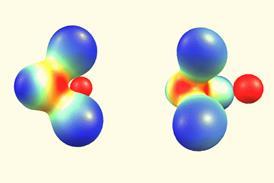Analysis
-
 Research
ResearchStructural disorder key to high-capacitance carbon electrodes
Finding could lead to supercapacitors that store more charge
-
 Research
ResearchMicroscopy structures reveal mechanism behind bitter taste
Cryo-EM images provide a detailed picture of bitter taste receptors
-
 Research
ResearchAlgorithm designs proteins from scratch that can bind drugs and small molecules
Strategy could stop an overdose or produce an antidote to a poison
-
 Research
Research‘Low-VOC’ paints may still release harmful volatiles
New analysis finds volatile compounds and potential allergens in several popular water-based paints
-
 Research
ResearchChemical analysis reveals origins of early English silver coins
Byzantine silver plates were melted down to make many of the first Anglo-Saxon coins
-
 Research
ResearchSimulations track how MOFs adsorb water, one molecule at a time
‘You can almost drink our water model because it’s so realistic’
-
 Research
ResearchUsing analytical chemistry to illuminate the unlisted ingredients in tattoo inks
Discovery that more than 80% of the tattoo inks sampled had unlisted ingredients prompts New York-based lab to launch a website providing chemical information to tattoo artists and their clients
-
 Research
ResearchTelling left from right: chirality detection faces up to its weaknesses
New solutions are being found to an enduring problem in chemistry
-
 Research
ResearchBrewing better Belgian beer with artificial intelligence
Machine learning tool can predict a beer’s taste and quality and which flavour compounds could improve it
-
 Research
ResearchWhy are there metal particles in never-used cannabis vapes?
Findings cast doubt on past research showing metals are solely released by e-cigarettes when the devices’ coils are heated
-
 Research
ResearchModel explains why water can freeze at different temperatures
The research could have applications in snowmaking, cloud seeding and beyond
-
 Research
ResearchLateral flow PFAS sensor could enable at-home water testing
New device offers fast and cheap way to monitor PFAS in drinking water
-

-
 Research
ResearchAI could provide new approach to assessing chemical toxicity thresholds in aquatic organisms
Model showed excellent predicative ability and could cut animal testing in pollution research
-
 Research
ResearchDebate surrounding amorphous selenium’s structure rumbles on
New evidence suggests that amorphous selenium forms eight-membered rings, but some researchers believe the results are inconclusive
-
 Research
ResearchPFAS contamination in Mersey basin among highest in the world, study suggests
Only two watersheds globally have higher yields of PFOS and PFOA
-
![[Br4F21]- index image](https://d2cbg94ubxgsnp.cloudfront.net/Pictures/100x67/1/7/3/532173_br4f21indeximage_49094.jpg) Research
ResearchUnusual bridging fluorine discovered in one-of-a-kind interhalogen ion
Similarity to MgAgAs crystal structure takes researchers by surprise
-
 Research
ResearchGPT-3 trained and tuned to predict molecular properties
A better understanding of Smiles helps GPT-3 recognise chemically relevant patterns
-
 Research
ResearchNew spray-on dyes can instantly reveal fingerprints at crime scenes
Fluorescent molecules are simple to use and non-toxic
-
 Research
ResearchHow a new carbon allotrope could change the definition of aromaticity
New experiments are uncovering the secrets of cyclocarbons– molecular forms of pure carbon that had eluded chemists for decades


